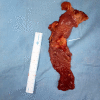Periampullary Carcinoma in a 13-Year-Old With Microsatellite Instability Treated Successfully With Pancreaticoduodenectomy
- PMID: 35308766
- PMCID: PMC8920813
- DOI: 10.7759/cureus.22139
Periampullary Carcinoma in a 13-Year-Old With Microsatellite Instability Treated Successfully With Pancreaticoduodenectomy
Abstract
Periampullary carcinoma in adolescents is very rare and may be associated with hereditary syndromes. Pancreaticoduodenectomy (PD) in adolescents is rarely performed. The experience and results of pancreaticoduodenectomy in adolescents are not well reported. Here, we report a case of periampullary carcinoma, duodenal origin, signet ring type with microsatellite instability (MSI), in a 13-year-old male for which pancreaticoduodenectomy was successfully done.
Keywords: cancer in young; microsatellite instability (msi); pancreaticoduodenectomy; periampullary carcinoma; whipple’s procedure.
Copyright © 2022, Kumarasamy et al.
Conflict of interest statement
The authors have declared that no competing interests exist.
Figures





Similar articles
-
Pylorus Preserving Pancreaticoduodenectomy vs. Standard Whipple's Procedure in Case of Carcinoma head of the Pancreas and Periampullary Carcinoma.Mymensingh Med J. 2015 Apr;24(2):319-25. Mymensingh Med J. 2015. PMID: 26007260 Clinical Trial.
-
Histopathologic Analysis of Pancreaticoduodenectomy Specimen.JNMA J Nepal Med Assoc. 2016 Oct-Dec;55(204):79-85. JNMA J Nepal Med Assoc. 2016. PMID: 28029673
-
The advantages of pylorus-preserving pancreatoduodenectomy in malignant disease of the pancreas and periampullary region.Ann Surg. 1992 Aug;216(2):142-5. doi: 10.1097/00000658-199208000-00004. Ann Surg. 1992. PMID: 1354435 Free PMC article.
-
The current status of preoperative biliary drainage for patients who receive pancreaticoduodenectomy for periampullary carcinoma: a comprehensive review.Surgeon. 2014 Oct;12(5):290-6. doi: 10.1016/j.surge.2014.02.004. Epub 2014 Mar 17. Surgeon. 2014. PMID: 24650759 Review.
-
Radical resection in signet ring carcinoma of the ampulla of Vater: report of an 11-year survivor.Am Surg. 2006 Feb;72(2):193-5. Am Surg. 2006. PMID: 16536256 Review.
Cited by
-
Challenges of Diagnosis: Periampullary Mass-Induced Obstructive Jaundice in a Young Woman.Cureus. 2024 May 24;16(5):e61013. doi: 10.7759/cureus.61013. eCollection 2024 May. Cureus. 2024. PMID: 38915985 Free PMC article.
References
-
- Pancreaticoduodenectomy for malignancies in children. d'Ambrosio G, del Prete L, Grimaldi C, Bertocchini A, Lo Zupone C, Monti L, de Ville de Goyet J. J Pediatr Surg. 2014;49:534–538. - PubMed
-
- DNA mismatch repair deficiency in ampullary carcinoma: a morphologic and immunohistochemical study of 54 cases. Agaram NP, Shia J, Tang LH, Klimstra DS. Am J Clin Pathol. 2010;133:772–780. - PubMed
Publication types
LinkOut - more resources
Full Text Sources
